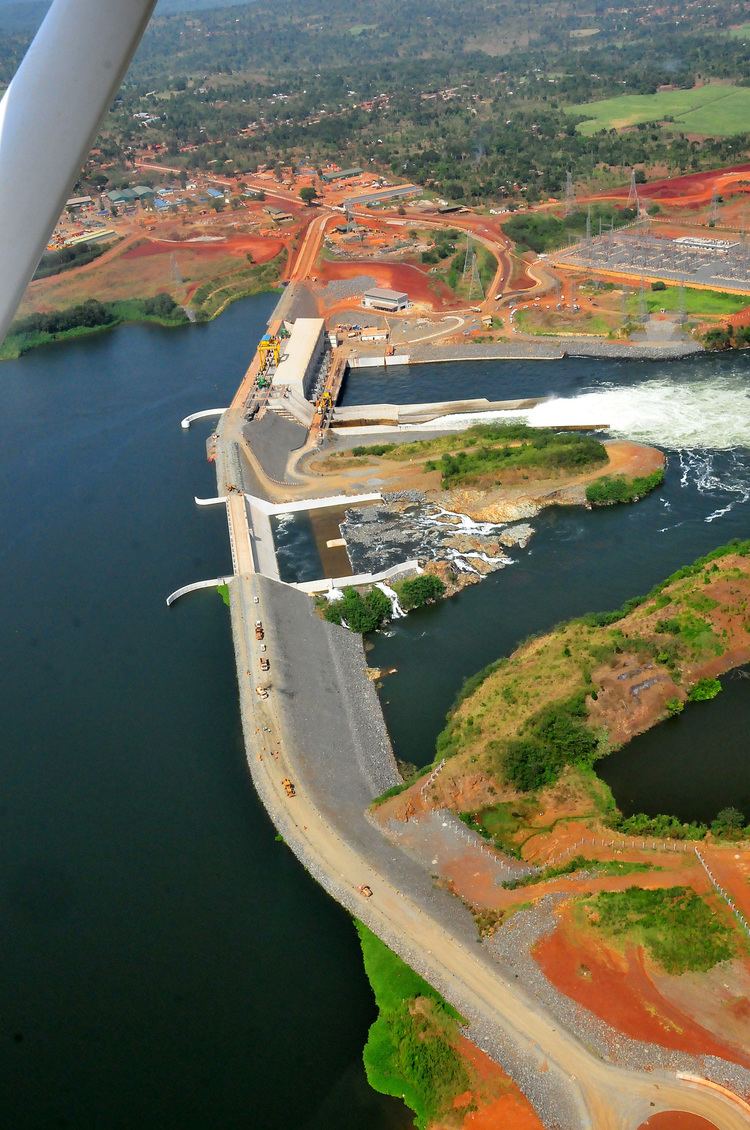Impounds River Nile Turbines 5 Construction cost 862 million USD Turbine 5 | Opening date 2012 Commission date 2012 Installed capacity 250 MW (340,000 hp) Construction began 2007 | |
 | ||
Similar Bujagali Falls, Nalubaale Hydroelectric Power St, Isimba Hydroelectric Power St, Owen Falls, Ayago Hydroelectric Power St | ||
The Bujagali Power Station is a hydroelectric power station across the Victoria Nile that harnesses the energy of its namesake – the Bujagali Falls – in Uganda. Construction began in 2007 and concluded in 2012. It was officially inaugurated on 8 October 2012 by Ugandan President Yoweri Museveni and Aga Khan IV in the presence of African politicians and investors.
Contents
- Map of Bujagali Hydroelectric Power Station Uganda
- Location
- History
- Ownership
- Construction costs
- Completion date
- The cost of power
- References
Map of Bujagali Hydroelectric Power Station, Uganda
The capacity of the power station is 250 megawatts (340,000 hp). The station is the most powerful hydroelectric energy source in Uganda, although the planned Karuma and Ayago power stations would be larger.
The funding for the station was a source of some concern, as investors joined and departed from the project. As of July 2014, the plant was managed by Bujagali Energy Limited, which selected Italian contractor Salini Impregilo to develop the project.
Location
The power station lies across the Victoria Nile, about 9.7 kilometres (6.0 mi) north-west of the town of Jinja and immediately north of the former location of the Bujagali Falls. It is at the border between Buikwe District to the west and Jinja District to the east. The coordinates of Bujagali Power Station are 0° 29'54.00"N, 33° 08' 15.00"E (latitude:0.498325; longitude:33.137500).
History
As far back as 2001, the government of Uganda started to plan the construction of a hydroelectric power plant at Bujagali Falls.
The original developers included AES Energy from the United States and the Madhvani Group from Uganda. In the midst of fraud investigations, the first project was abandoned in 2003 when AES Energy pulled out of the deal, citing a protracted process because of objections from environmentalists.
A new consortium, Bujagali Energy Limited, was created by Sithe Global Power LLC, from the United States, and Industrial Promotion Services, a division of the Aga Khan Fund for Economic Development, and was tasked with developing the project. Construction of the dam and powerhouse started in June 2007. Salini Impregilo was selected to be the lead contractor. The power station began commercial operations on 1 August 2012. At the peak of construction activity, the project employed over 2,500 people, including about 2,200 Ugandan nationals.
Ownership
As of January 2010, Bujagali Energy Limited was owned by the following entities:
Construction costs
The estimated costs for the dam and power plant was US$800 million. Another $62 million was spent on building a high voltage transmission line from Jinja to Kawanda, near Kampala, a distance of about 80 kilometres (50 mi).
Bujagali Energy Limited invested approximately US$190 million of its own money into the project. The rest of the funds were borrowed from the following international lenders:
- International Finance Corporation, a member of the World Bank Group
- African Development Bank
- European Investment Bank
- German Investment Corporation
- KfW
- PROPARCO of France
- French Development Agency
- Netherlands Development Finance Company
Completion date
The project was completed in 2012, although partial power generation started in 2011.
In April 2010, The EastAfrican, a Kenyan weekly publication, indicated that the opening of the dam would be phased, one unit at a time. On 2 February 2012, Ugandan newspapers reported the commissioning of the first turbine of the power station. In May 2012, the third 50 megawatt turbine was commissioned, bringing output to 150 megawatts. On 15 June 2012, Ugandan press reports indicated that the fourth and fifth turbines had come online, bringing total output to 250 megawatts. The plant officially began commercial operation on 1 August 2012.
The cost of power
As of October 2016, the dam's utilization rate was approximately 70 percent. The power generated cost the end user about US$0.11/kilowatt-hour, which was the highest rate in the East African Community. In September 2016, the government of Uganda began negotiations with equity partners and lenders to restructure the financing of the dam to reduce the cost to the end-user to about US$0.072/kilowatt-hours.
